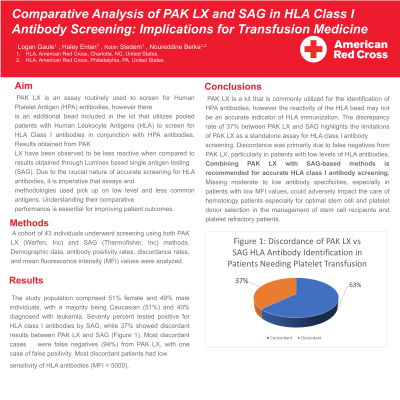Back

Comparative Analysis of PAK LX and SAG in HLA Class I Antibody Screening: Implications for Transfusion Medicine
(P423) Comparative analysis of PAK LX and SAG in HLA class I antibody screening
Location: Platinum Ballroom

- DJ
Poster Presenter(s)
Aim: Pak LX is an assay routinely used to screen for Human Platelet Antigen (HPA) antibodies, however there is an additional bead included in the kit that utilizes pooled patients with Human Leukocyte Antigen (HLA) antigens to screen for HLA Class I antibodies in conjunction with HPA antibodies. Results obtained from Pak LX have been observed to be less reactive when compared to results obtained through single antigen testing (SAG). Due to the crucial nature of accurate screening for HLA antibodies it is imperative that assays and methodologies used pick up on low level and less common antigens. Understanding their comparative performance is essential for improving patient outcomes.
Method: A cohort of 43 individuals underwent screening using both PAK LX and SAG method. Demographic data, antibody positivity rates, discordance rates, and mean fluorescence intensity (MFI) values were analyzed.
Results: The study population comprised 51% female and 49% male individuals, with a majority being Caucasian (51%) and 40% diagnosed with leukemia. Seventy percent tested positive for HLA class I antibodies by SAG, while 37% showed discordant results between PAK LX and SAG. Most discordant cases were false negatives (94%) from PAK LX, with one case of false positivity. Most discordant patients had low sensitivity of HLA antibodies (MFI < 5000).
Conclusion: PAK LX is a kit that is commonly utilized for the identification of HPA antibodies, however the reactivity of the HLA bead may not be an accurate indicator of HLA immunization. The discrepancy rate of 37% between PAK LX and SAG highlights the limitations of PAK LX as a standalone assay for HLA class I antibody screening. Discordance was primarily due to false negatives from PAK LX, particularly in patients with low levels of HLA antibodies. Combining PAK LX with SAG-based method is recommended for accurate HLA class I antibody screening. Missing moderate to low antibody specificities, especially in patients with low MFI values, could adversely impact the care of hematology patients especially for optimal stem cell and platelet donor selection in the management of stem cell recipients and platelet refractory patients.
Method: A cohort of 43 individuals underwent screening using both PAK LX and SAG method. Demographic data, antibody positivity rates, discordance rates, and mean fluorescence intensity (MFI) values were analyzed.
Results: The study population comprised 51% female and 49% male individuals, with a majority being Caucasian (51%) and 40% diagnosed with leukemia. Seventy percent tested positive for HLA class I antibodies by SAG, while 37% showed discordant results between PAK LX and SAG. Most discordant cases were false negatives (94%) from PAK LX, with one case of false positivity. Most discordant patients had low sensitivity of HLA antibodies (MFI < 5000).
Conclusion: PAK LX is a kit that is commonly utilized for the identification of HPA antibodies, however the reactivity of the HLA bead may not be an accurate indicator of HLA immunization. The discrepancy rate of 37% between PAK LX and SAG highlights the limitations of PAK LX as a standalone assay for HLA class I antibody screening. Discordance was primarily due to false negatives from PAK LX, particularly in patients with low levels of HLA antibodies. Combining PAK LX with SAG-based method is recommended for accurate HLA class I antibody screening. Missing moderate to low antibody specificities, especially in patients with low MFI values, could adversely impact the care of hematology patients especially for optimal stem cell and platelet donor selection in the management of stem cell recipients and platelet refractory patients.
